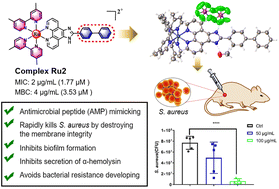The synthesis and antibacterial activity study of ruthenium-based metallodrugs with a membrane-disruptive mechanism against Staphylococcus aureus†
Abstract
The wide spread of drug-resistant bacteria, especially methicillin-resistant Staphylococcus aureus (MRSA), poses a tremendous threat to global health. Of particular concern, resistance to vancomycin, linezolid, and daptomycin has already been reported in clinical MRSA strains. New antibacterial agents are urgently needed to overcome this crisis. Here, we designed and synthesized a series of ruthenium-based antibacterial agents via targeting bacterial membrane integrity. Structure–activity relationship studies demonstrated that both the lipophilicity/hydrophilicity ratio and biphenyl group play an important role in elevating the antibacterial activity. To characterize the antibacterial mechanism, we combined scanning electron microscopy, propidium iodide dyeing, and DNA leakage assays. The results demonstrated that Ru2 could destroy the integrity of bacterial cell membranes. In addition, Ru2 can efficiently inhibit biofilm formation and α-hemolysin secretion from Staphylococcus aureus. Finally, in both a mouse skin infection model and a G. mellonella wax worm infection model, Ru2 showed significant antibacterial activity in vivo. Moreover, the Ru2 complex was almost non-toxic. Thus, this work demonstrated that ruthenium-based complexes bearing a biphenyl group are promising agents to combat bacterial infection.



 Please wait while we load your content...
Please wait while we load your content...